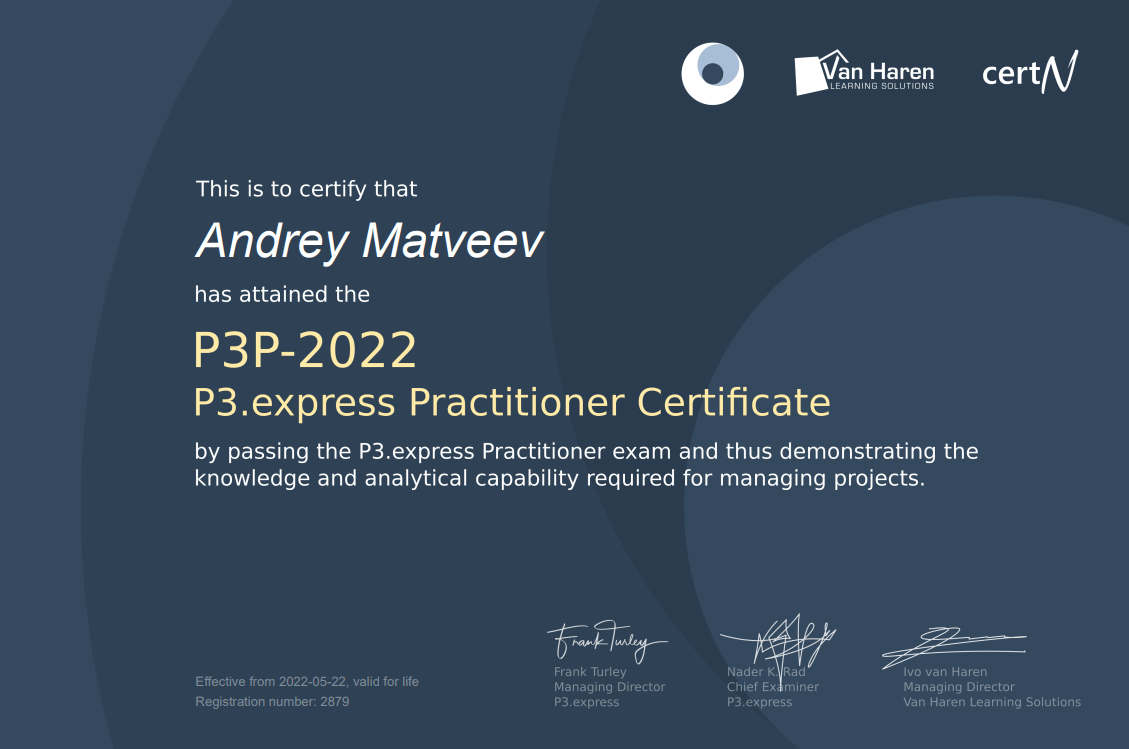I adhere to the principles of lifelong learning (continuous education) and therefore I am always looking for opportunities to acquire and apply new knowledge. I learned about P3.express at the end of 2020, and already at the beginning of 2021 I began to partially use it.
I decided to get a certificate for 2 reasons:
1) Knowledge assessment. Revising for such an exam allowed me to fill in the remaining gaps.
2) Documentary evidence. I, for one, appreciate people’s skills and abilities, but not all people think the same. For example, in agreeing on a project team, one of my customers skipped years of relevant experience and deep knowledge of the topic in favor of university diplomas and professionally-oriented certificates. Therefore, it is good to support knowledge with a certificate, but not vice versa.
Why P3.express
At the time of taking P3.express Practitioner, I already was equipped with:1) PMP,
2) Google Project Management,
3) Project Management Expert (PME),
4) Six Sigma white belt.
And then the question arises - why do I also need P3.express? And the answer is simple - none of the certifications listed above completely satisfies me from a professional point of view.
I work in the B2B sector with a wide range of Clients from sole proprietors to the largest national holdings. And everyone has different needs, sometimes it’s just a 2-months consulting, and in other cases it’s a ong-term project with a sizeable team. P3.express, seems to be a framework that can be adapted to different situations, simplifying or increasing the sophistication of the framework. PMP from this perspective is very cumbersome and deep, Google offers a more dynamic system, but it is tailored only to IT, PME is not much different from PMP, and Six Sigma manifests itself through a process standardization which is not relevant to me.

About the course
Now about the course. It’s divided into 4 parts:1) Introduction;
2) Learning framework;
3) Implementation and adaptation;
4) Preparation for successful examination.
I see no point in focusing on the introduction.
The training block is divided into 7 modules according to the framework activity groups, for each activity there is a separate lesson and a task, as well as a test for each module. Each lesson includes a video and a summary. And it's very cool, because most other courses either consist of recorded videos or loads of text and links. The course in this case offers the opportunity to study using a convenient format.
The implementation and adaptation block allows you to read about colleagues' expertise and learned practice instead of theory. After all, even in school days it was useful not only to write answers, but also to compare them with your classmates.
The last block contains tips on revising for the exam itself. Surprisingly, the strongest piece of advice is missing here, but more on that later. The block accomplishes its mission and gives an understanding of what I need to do to get a certificate.
My approach
I got down to study on May 1 and received the certificate on May 22. In total, I spent about 8 hours on training.The first step was to make a plan. I decided to study 2 times a week for 1 hour plus 2 hours for revision on the day of the exam. At that rate, I planned to pass the exam at the end of the month.
During the training I had to adjust the plan twice:
1) Until the end of the May holidays, I allocated only half an hour;
2) On the last day of the holidays (May 11) I realized that I was not ready to watch the video. The summary contains all the necessary information, and having basic speed reading skills, I read it in 2 minutes, while the video at 1.5x speed took about 7 minutes, so by the end of the week I learned the main part and decided to take the exam next weekend.
On the day off, I allocated 4 hours for the exam, and assured myself of peace and quiet for that time. The first 2 hours I spent revising:
1) NUPP;
2) Code of Conduct;
3) Chapters of the course;
4) Exam simulator.
Then, start the exam, doubts about a number of questions, exhale, click on complete - passed!
Initially, I wanted to tell you my tips about how to read the questions, but in the process of writing a review, I realized that my approach needs some getting used to, so I'll tell you about it here.
Each exam question contains 4 answer options, the question itself and a description of the situation. Moreover, the description of the situation may differ in the amount of text from one line to a couple of paragraphs. Therefore, I always read the answers first, then - the question, and only after that - the entire description of the situation, so that I already understand what I need to find there. This does not guarantee right answers, but saves precious time, enabling you to answer at the first try, without re-reading the question and answers.
To pass, you must correctly answer 67% of the questions; this is quite a reasonable percentage. There is a little deceit here - the questions are not distributed evenly across topics, so you need to revise thoroughly and know everything, not relying on good luck and fortune.
Tips for those who want to pass
In this section, I want to share a number of tips that I hope will help you. This is not the ultimate truth; I recommend you read them critically, ask yourself the question - is this suitable for me?Basis of preparation - the activities of the framework.
That was my main mistake – during the revision I did not read the most important thing - the activities of the framework themselves! I only studied the notes and all the rest of it. Some of the questions have almost word-for-word answers in the description of the activities. This is the primary base for preparation.
How we memorize
Before you do something, learn how to do it. Read how memory works, what rhythm is, how sleep affects, what techniques can be used. It is easy to find many articles on this topic on the Internet. For example, here.
Planning is the basis for everything
Exam preparation is another project that needs to be planned. Estimate your reading period, when and how long you are ready to study, plan the exam date right away.
NUPP guide
Although it’s not an official part of P3.express, the exam does include NUPP logic questions. Be sure to read this.
P3.express Practitioners Code of Conduct
This is another document that it is necessary to become familiar with. "Document" is something of an overstatement, because it contains only 6 points. The test included some questions about it. And these issues do not always correspond to the background environment we do business in, so they need to be looked at from the perspective of the code.
Practice exam
Must be studied and comprehended. During the exam, I came across some tricky questions that were similar to practice ones, but rephrased.
Project Simulator
A good way to improve your practical skills. The key word here is practical. This is a very good tool, but in my opinion, it does not help much with revising for the exam.









